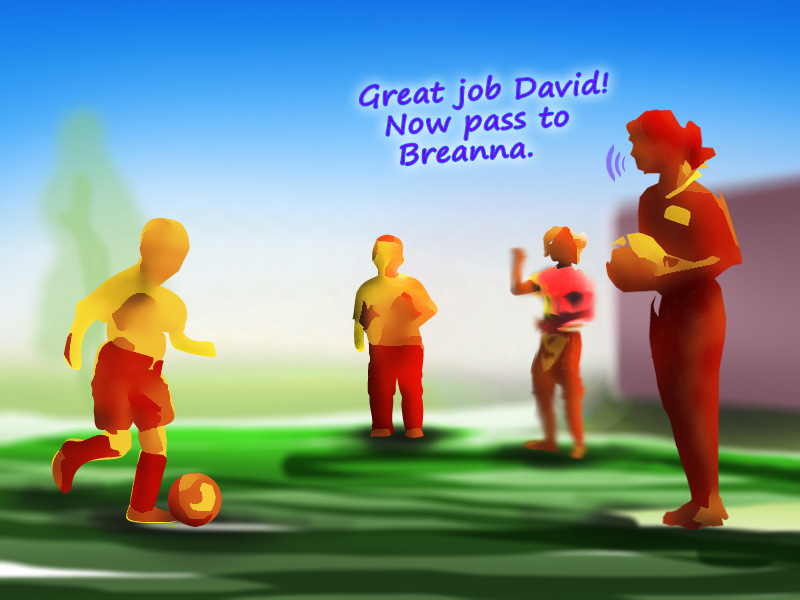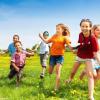- Reflect on the importance of physical activity in your own life.
- Describe the benefits of physical activity for children, families and staff members.
- Describe a program that promotes physical activity.
Learn
Teach
Most American adults spend a great amount of time sitting. You are probably sitting right now as you read this course. Take a second to check in with yourself. How long have you been sitting? How long do you plan to be sitting while you complete this course? What effect does all this sitting have on your emotional state? How do you feel right now? Are you tired, unenthusiastic or bored? Perhaps you have been on your feet all day and it feels good to sit down.
Now take 10 seconds to do something different. Stand up. Wiggle your toes and reach your arms up over your head. Look away from the screen and roll your head from one side to the other. Do you feel any different after this very short amount of movement?
For most of us, even a very short period of physical activity can improve our energy and outlook. The change may not be drastic, but perhaps you feel like you can pay attention for a little bit longer than you could originally. Obviously, wiggling your toes for 10 seconds is not going to have a meaningful impact on your overall health, but this experience gives you a small insight into the power of physical activity.
According to the U.S. Centers for Disease Control and Prevention, an adult between the ages of 18 and 64 needs at least 150 to 300 minutes of moderate-intensity movement (like brisk walking) per week and muscle-strengthening activities on two or more days per week. This level of physical activity can help you:
- Reduce your risk of heart disease, stroke, and high blood pressure
- Reduce your risk of type 2 diabetes and depression
- Prevent eight types of cancer: bladder, breast, colon, endometrium, esophagus, kidney, stomach, and lung
- Strengthen your bones and muscles
- Improve your mood and mental health
- Improve your ability to complete daily activities and lower the risk of falls and injuries from prevent falls
- Increase your chances of living a longer life
- Manage more health conditions such as decreased pain from osteoarthritis, reduce disease progression for hypertension and type 2 diabetes, reduce symptoms of anxiety and depression, and improve cognition for those with dementia, multiple sclerosis, ADHD and Parkinson’s disease.
- New evidence also shows that physical activity has immediate health benefits, such as a reduction in anxiety and blood pressure, and improved quality of sleep and better insulin sensitivity (U.S. HHS, 2018).
It can be difficult to find the time for physical activity, but clearly the results are worth it. When you are physically active, you are better able to be your “best self.” You have the energy and health to make a difference in your workplace, with your family, and in your community.
Model
Physical development is one domain of development. It relates to the changes, growth and skill development of the body, including the brain, muscles and senses. Physical development is evident primarily in gross motor and fine motor skills. These skills are essential to children’s overall health and wellness. Gross motor skills involve the use of large muscles in the legs or arms, as well as general strength and stamina. Examples of such skills include jumping, throwing, climbing, running, skipping or kicking. Fine-motor skills involve the use of small muscles in the arms, hands, and fingers and are supported by advancements in perception. Examples of such skills include stringing beads, scribbling, cutting or drawing. Fine-motor skills enable children to perform a variety of self-help tasks such as using utensils or dressing themselves.

Children’s motor abilities develop as a result of physical development and growth. As their bodies mature over time, children progressively strengthen their muscles and become able to better control their bodies. Skill mastery and development, however, are also the result of brain growth and development. Consider a preschooler kicking a ball back and forth with a peer. This child must have acquired control over movement and muscles to be able to kick the ball. At the same time, the child also depends on vision to determine the location and direction in which to kick the ball and on hearing instructions from a peer or caregiver. As children move through the school-age years, their bodies and minds become capable of increasingly more-complex movement patterns and experiences.
The Role of Culture in Physical Activity
Children’s physical development is influenced by many factors, including the backgrounds and experiences of the families and staff in your program. As a Training & Curriculum Specialist, take time to understand the beliefs, values, and traditions that shape views on physical activity. Culture may influence perspectives such as:
- Whether taking time to exercise is considered self-care or selfish
- Whether physical activity is built into chores and daily activities
- How body size is associated with health, wealth, or well-being
- What sports or activities boys and girls (and men and women) are encouraged to do
- Whether physical health can be influenced by personal choices or whether it is in the hands of a higher power
- How the mind and body are connected
- Whether movement is part of religious practices or family customs
- Clothing or garment requirements
It’s also important to consider how the physical environment can impact activity levels. A person’s experiences, surroundings, and background often work together to shape their choices about physical activity. For example:
- Is it possible to walk around your community, or is it considered unsafe?
- Are there sidewalks or walking paths?
- Are cars required for running errands or meeting basic needs?
- Are there traditional seasonal activities—such as hunting or berry picking—that families enjoy?
- Do children, youth, and families have access to safe spaces and equipment for sports and games (e.g., basketball courts, fields, gyms, dance floors, swimming pools)?
- Are there opportunities to participate in meaningful sports, games, or movement practices from around the world (e.g., cricket, Tai Chi, music and dance)?
Physical Activity for Staff, Families, and Children
The mental and physical health benefits of activity are extensive. You have read about how important physical activity is for yourself. The same holds true for the staff members, families and children with whom you work. Let’s explore each group.
Staff Members
Physically active staff members make a difference for a variety of reasons:
- Physical activity promotes health. When staff members are active and healthy, they typically miss fewer days due to illness.
- Physical activity decreases stress and promotes mental well-being. When staff members take time to be physically active, they can handle the pressures of their jobs and family life better. This includes being able to have positive interactions with children and families in the program.
- Staff members serve as role models. It is important for children and youth to see adults engaging in healthy habits like exercise. Children are more likely to participate in physical activities when they are surrounded by others who are interested and engaged.
Families
- Being physically active together can be fun for families. A long walk, hike, or bike ride can create meaningful memories for children and parents. Physical activity is also an inexpensive way for families to connect. Choosing to take the stairs together is free!
- When families engage in physical activity, they experience health benefits. These benefits might include reduced risk of cardiovascular diseases, enhanced mental health, and more energy. Adults pass these health benefits and habits on to their children when they model physical activity if the family is active together.
Children
Physically active children are more likely to sleep better, have better mental health, maintain strong bones, avoid obesity-related diseases, and even do better in school (HHS, 2018). Children who are physically active also have more opportunities to develop muscle strength and endurance. They are more likely to feel confident about themselves and their bodies as they grow (Healthy Kids, Healthy Future, 2022).
Physical activity gives children access to learning across domains. An infant who rolls over or pulls up expands her information about the surrounding world. She can look at, touch, and taste a wider array of objects. A preschooler who jumps in puddles explores concepts of physics. A school-age child who joins a group soccer game broadens his social connections.
Physical activity is a healthy way for children to spend their time. The more time children spend in physically active play, the less time they tend to spend in more sedentary activities like video games or screen time. By encouraging physical activity and nurturing a love of movement, you help children and youth make healthy decisions about their time. This sets them on a positive trajectory that helps build social connections, physical health, resilience, and overall wellbeing into adulthood.
Observe
Now that you have learned the importance of physical activity for yourself, staff, families, and children, it is time to think about how your program promotes physical activity. Throughout this course, you will hear from staff members, administrators, and Training & Curriculum Specialists from exemplary programs. Think about how you can apply what you see to your own work.
Programs That Promote Physical Activity
Completing This Course
For more information on what to expect in this course and a list of the accompanying Learn, Explore and Apply resources and activities offered throughout the lessons, visit the Training & Curriculum Specialist Physical Development Course Guide.
To support the professional development of the direct care staff members or family child care providers you oversee, you can access their corresponding Course Guides:
- Infant & Toddler Physical Development Course Guide
- Preschool Physical Development Course Guide
- School-Age Physical Development Course Guide
- Family Child Care Physical Development Course Guide
Explore
The Healthy Kids Healthy Future website has developed a variety of tools to help children, adults, and communities become more active. To get a baseline read for how well your program incorporates physical activity into its program, complete the Healthy Kids, Healthy Future Checklist Quiz. When you are finished, reflect on what your program is currently doing and where improvements can be made. Share a copy of this quiz with your team.
Apply
Review the list of resources in Resources That Promote Activity to learn strategies for supporting children's motor development through everyday routines and experiences. Reflect on new approaches you can implement in your program to enhance motor skill development. Then, identify and discuss the strategies or experiences you would like to share with staff and families.
Glossary
Demonstrate
Centers for Disease Control and Prevention. (2021). Benefits of physical activity. http://www.cdc.gov/physicalactivity/everyone/health/index.html
Carlson, F. M. (2011). Big body play. National Association for the Education of Young Children.
Copeland, K. A., Kendeigh, C. A., Saelens, B. E., Kalkwarf, H. J., & Sherman, S. N. (2011). Physical activity in child-care centers: Do teachers hold the key to the playground? Health Education Research, 27(1), 81–100. https://www.ncbi.nlm.nih.gov/pmc/articles/PMC3258280/
Healthy Kids Healthy Futures. (2022). Resources for early care and education providers. https://healthykidshealthyfuture.org
Honig, A. S. (2015). Experiencing nature with young children: Awakening delight, curiosity, and a sense of stewardship. National Association for the Education of Young Children.
Kids Health. (2022). Nutrition & fitness center. https://www.kidshealth.org/en/parents/center/fitness-nutrition-center.html
Pica, R. (2014). Moving and learning: A physical education curriculum. Redleaf Press.
Playworks. (2020). Game library. Sports4Kids. https://www.playworks.org/game-library/
Sanders, S. W. (2002). Active for life: Developmentally appropriate movement programs for young children. National Association for the Education of Young Children.
2018 Physical Activity Guidelines Advisory Committee. (2018). 2018 Physical Activity Guidelines Advisory Committee scientific report. U.S. Department of Health and Human Services. https://health.gov/our-work/physical-activity/current-guidelines
U.S. Department of Health and Human Services, Office of Disease Prevention and Health Promotion. (2018). Physical activity guidelines for Americans (2nd ed.). https://health.gov/paguidelines/second-edition/


